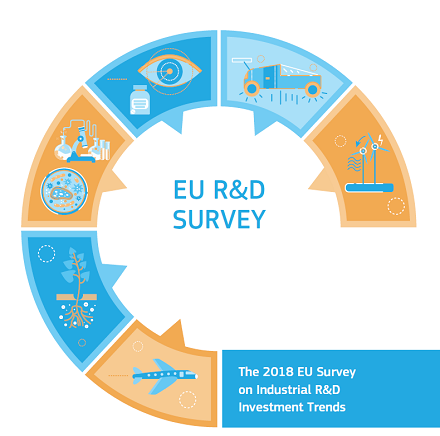Body
The 142 EU companies participating in the EU Survey on Industrial R&D Investment Trends expect R&D investment to increase by 5.4% per annum in 2018 and 2019. This is higher than last year's expectation (4.7%) and indeed the highest expected increase since the pre-crisis years (2007). Companies in the ‘ICT Producers' and ‘Automobile and Other Transport' sector groups expect their R&D to increase the most.
These top EU R&D performers expect their R&D within the EU to increase by 4.5% p.a., while their R&D in China and India is expected to show double digit growth (+21.3% and +11.2% respectively). The proportion of R&D investment by EU firms within the EU shows a stable trend since 2006 (at around three-quarters), not showing signs of erosion or offshoring to other regions. In absolute terms, R&D investment levels are higher than ever in the EU.
EU firms are increasingly becoming truly global in their R&D activities. In the 2006 survey, only about 15% of EU firms performed R&D in the main world regions. This figure has been constantly increasing, now representing 33% of all participating firms. This confirms both the increasingly global character of R&D and the growing need for top R&D investors to be present in the main R&D locations around the world.
China is expected to become the third largest region for the location of R&D activities by EU firms by 2019, after the EU and the US. The proportion of R&D investment by EU firms performed in China is expected to grow to 3.4% in 2019 (from 2.6% in 2017). Since the start of the survey, the third largest region has been the Rest of the World. However, China and India show consistently high growth expectations in all editions of the survey, indicating interesting developments in these countries that are attracting the attention of the EU's main R&D performers.
As in all previous surveys, low labour costs for researchers prove not to be an important factor of attractiveness in locating R&D activities. However, there is an important caveat to this finding: firms performing R&D in China or India rate low labour costs as much more important than firms without R&D activities in these countries. Also, companies that perform R&D in many countries rate this factor as much more important than firms performing R&D in only one or a few countries. India is gaining strength as a popular R&D location and is currently second after the US.
Firms that perform R&D only in the EU rate the proximity to other activities within the company and the quality of public research as highly important for their location of R&D activities. Firms with R&D activities in the US rate the proximity to suppliers and access to specialised R&D knowledge much higher than firms without R&D activities in the US. The quality of researchers is a factor that is rated consistently highly by firms with R&D activities in the EU only, or that focus on either the US or on China or India, which implies that frontier research is geographically dispersed to all regions.
The most highly rated factors for locating production by EU only firms are macroeconomic stability, access to its production infrastructure and quality of personnel. Overall, the factors most often rated as (highly) attractive by firms are access to markets, quality and availability of personnel and macroeconomic stability.
Low labour costs are perceived as much more important by firms that produce in China or India than firms that do not. China, Brazil, Italy and Russia remain the countries more frequently mentioned as a production location, as in last year's survey. Access to markets is an important factor for locating production activities in China or India, but not R&D.
The average non-R&D expenditure of the respondents is €54 million: 29% of their R&D expenditure or a non-R&D intensity (non-R&D expenditure over net sales) of 0.5%.
Firms invest mainly in applied research activities, rather than basic research. This finding is consistent over many editions of the survey and suggests that the European Innovation system has to rely on other actors (i.e. universities and public research institutes, but also start-ups and disruptive companies) for investment in basic research.
The main motivation for firms to allow their employees to publish articles in scientific journals is to build the firm's reputation. This helps them to send out a message to two types of audience: venture capital funds (that may be interested in investing in a firm where relevant scientific work is produced) and other talented scientists (who may be interested in working in a scientifically stimulating environment). However, strong differences emerge when comparing firms with high publishing output to those with low output.
Companies do not specifically ask for less regulation, but ask for it to be simplified. When asked what public policies should be implemented to boost private R&D and innovation activities, firms call on public authorities to complement their own action through funding research projects and increasing public-private cooperation.
Date
Link to report
Publication Type
Area of work
Cover
